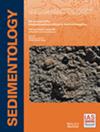On the origin of chevron marks and striated grooves, and their use in predicting mud bed rheology
IF 2.8
2区 地球科学
Q1 GEOLOGY
引用次数: 0
Abstract
ABSTRACT Understanding of the formative conditions of many sole structures is limited, with chevron marks and striated groove marks being particularly enigmatic. These sedimentary structures are examined here through laboratory modelling. An idealized tool, resembling an armoured mud clast, was dragged through substrates of kaolinite–seawater mixtures of different yield strengths while submerged in seawater. The experiments suggest that armoured mud clasts are the likely tools producing fine striae in striated grooves and given the common occurrence of striated groove marks in outcrops, that these clasts are more prevalent in deep‐marine settings than previously thought. Chevron marks were observed to form over a narrow range of substrate yield stresses, likely explaining their relative rarity. Furthermore, their form is shown to be a function of substrate rheology, with chevron angle relative to the movement direction of the tool being less in weaker substrates. Moreover, the size of cut chevron marks, characterized by a narrow central cut, bears no relationship to the size of the incising tool, but rather reflects a substrate with a low yield stress that is sufficiently mobile to close behind the tool. In contrast, interrupted chevron marks, characterized by a distinct central groove, reflect greater substrate strength. Striated grooves without chevrons formed at the highest yield stresses simulated in the experiments. The relationship between tool mark type and yield stress, in combination with changes in chevron angle, enables these sole structures to be utilized as indicators of palaeosubstrate rheology. The conditions required to preserve such features include a prolonged period of bed consolidation, flow bypass and lack of bioturbation. Given changes in seafloor communities and bioturbation over time and their impact on substrate rheology, particularly during the early Palaeozoic, the present work supports the idea that the frequency of these sole structures likely changed over geological time.论三角纹和条纹纹的起源及其在预测泥床流变学中的应用
对许多鞋底构造形成条件的了解是有限的,其中纹路纹和条纹纹尤其令人费解。这些沉积构造在这里通过实验室模型进行检验。一种理想的工具,类似于装甲泥浆碎屑,被拖入海水中,穿过不同屈服强度的高岭石-海水混合物的基质。实验表明,盔甲泥碎屑可能是在条纹沟槽中产生细条纹的工具,并且考虑到在露头中常见的条纹沟槽标记,这些碎屑在深海环境中比以前认为的更为普遍。我们观察到,在很窄的底物屈服应力范围内形成的雪佛龙标志,可能解释了它们相对罕见的原因。此外,它们的形式被证明是基材流变学的函数,相对于工具运动方向的角在较弱的基材中较小。此外,切割的纹路痕迹的大小,以狭窄的中心切口为特征,与切割工具的大小无关,而是反映了具有低屈服应力的基底,该基底具有足够的流动性,可以在工具后面闭合。相反,以明显的中心凹槽为特征的断裂性纹路,反映出较强的承印物强度。在实验模拟的最高屈服应力下,形成了无线形的条纹凹槽。刀痕类型与屈服应力的关系,结合刀角的变化,使得这些鞋底构造可以作为古基底流变学的指示物。保持这些特征所需的条件包括长时间的床层固结、流体旁路和缺乏生物扰动。考虑到海底群落和生物扰动随时间的变化及其对基质流变学的影响,特别是在早期古生代,目前的工作支持这样的观点,即这些单一结构的频率可能随着地质时间而改变。
本文章由计算机程序翻译,如有差异,请以英文原文为准。
求助全文
约1分钟内获得全文
求助全文
来源期刊

Sedimentology
地学-地质学
CiteScore
8.20
自引率
11.40%
发文量
94
审稿时长
6-12 weeks
期刊介绍:
The international leader in its field, Sedimentology publishes ground-breaking research from across the spectrum of sedimentology, sedimentary geology and sedimentary geochemistry.
Areas covered include: experimental and theoretical grain transport; sediment fluxes; modern and ancient sedimentary environments; sequence stratigraphy sediment-organism interaction; palaeosoils; diagenesis; stable isotope geochemistry; environmental sedimentology
 求助内容:
求助内容: 应助结果提醒方式:
应助结果提醒方式:


